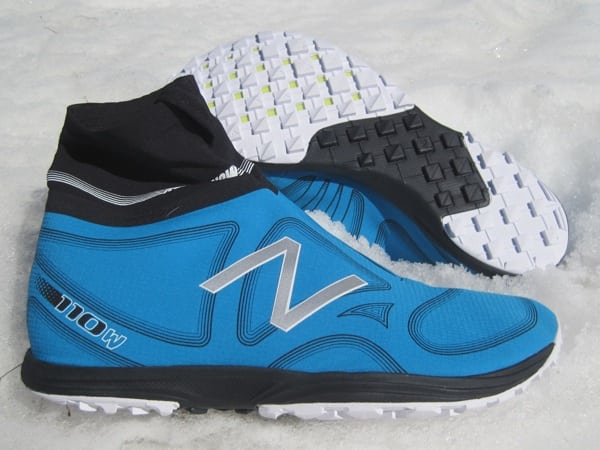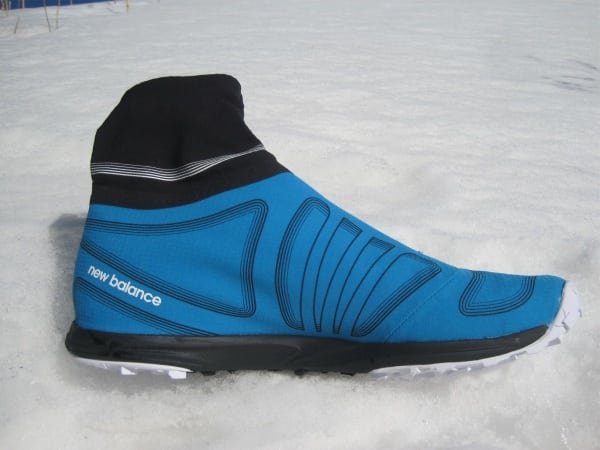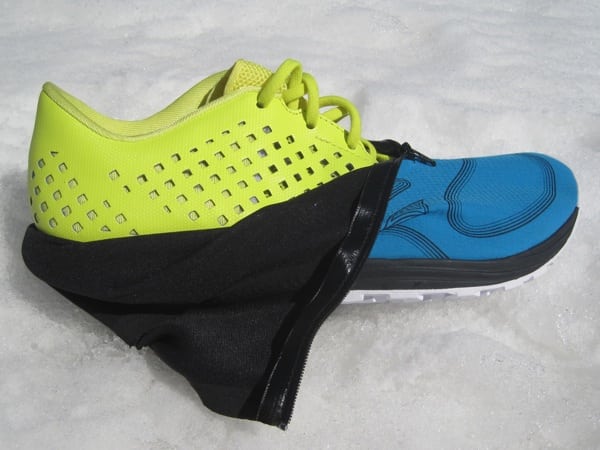Our Favorite Trail Running Shoes
Check out our Best Trail Running Shoes article to learn about our current favorite trail running shoes!
Winter Running Traction Devices
For adding more winter traction to your shoes, check out our Best Winter Running Traction Devices guide.
New Balance MT110W Review
As the New Balance MT110W is specifically a winter variant of the previously reviewed MT110’s, this review focuses on the cold-weather features of the shoe and their performance in the best that winter has to offer. As a result, I am going to split my observations on the M110W’s between the uppers and the soles. The midsole and its construction went unmodified for the “W” version and performs as one would expect a standard MT110 midsole to perform.
Upper
The bright blue upper of the MT110W’s stands out in both color and design. A few trail shoe manufacturers are now offering winter shoes combining a waterproof upper with an integrated gaiter. Being a dedicated winter runner, I applaud New Balance’s attempt with this type of construction.
The upper’s material feels similar in weight and durability to a higher-end waterproof shell. It has some stretch to it, but also feels robust enough to withstand a few hazards. New Balance crafted the entire outer portion of the upper in one piece, with the seam being at the heel of the shoe. The seam is taped and, I suspect, should remain watertight as the heel doesn’t see a lot of flex or abuse. Smart.
Around the ankle, the upper itself forms a gaiter. I have to admit I was initially skeptical as to whether this would be effective given that there’s no means of tightening the gaiter’s neck. So, you are stuck with the seal that the elastic gives you. My ankle is 9.5-9.75″ at the gaiter’s neck and have found the gaiter to be reliable through knee-deep snow.
As with any waterproof pieces of outdoor equipment, there are issues with breathability. How soggy do your feet get? Well, to put it simply, WAY less damp than if you are running in snow without waterproofing. And, most important, I have never had my feet get wet enough that they got cold. For winter athletic apparel, that’s success in my book.
My big critique of the upper is the zipper. It has very small teeth and hesitates on me when I am trying to unzip after a long run. It doesn’t take much ice or snow build-up to slow it down or freeze it in its tracks. In addition, through the years, I have found smaller zippers to be more prone to failure over time. While I am sure NB has reasons for picking such a diminutive zipper, I think moving up a couple of sizes would be an excellent (and necessary if frozen) revision.
[Bryon’s Note: It’s worth noting that the MT110W has a two-part upper. Adam has described the external layer that provides a full-shoe waterproof wrap as well as the gaiter. Underneath, New Balance has done a solid job of paring down the structural portion of the MT110’s upper – eliminating the plastic-y laser-cut layer and cutting away significant portions of the underlying fabric. This helps keep the shoe really light – 9.1 ounces (258 g) for a US men’s 9.5 (not 9) – despite having two layers.]
Outsole
The sole on the MT110W’s is the same as the sole on standard MT110’s. I love the proprioception and traction of the standard MT110’s throughout the other three seasons of the year. New Balance did a solid job on that design for a warmer-weather trail shoe.
However, it is a miserable winter sole. The low-profile lugs which make it so much fun over trails in the summer do very little for the shoe in deeper snow and does not stick well on hard-pack or ice. The best thing I can say about the sole on the MT110W’s is that it provides enough rubber for screws. It also interfaces well with Kahtoola MICROspikes (but I haven’t found a shoe that doesn’t yet).
Does it need deeper and more aggressive lugs? Yes. Would I sacrifice ground-feel for that? Yes. Honestly, not updating the sole to something a bit more winter-specific is a huge oversight. It’d add weight and change the feel of the shoe some. But, then again, so does running in snow.
[Bryon’s Note: More than regretting a lack of traction with the MT110W’s outsole (I usually got enough, though certainly not great traction on Park City’s snow-packed trails last winter. My initial notes were, “decent traction on snow and ice.”), I found that I really wanted additional underfoot structure on the snow. In running in the standard MT110, I appreciate the ground feel and enjoy the shoes for up to 8 or 10 miles on trails. However, with the snow’s extra and unpredictable give, I found my feet getting overworked in half the distance.]
Conclusion
I give New Balance high marks for entering into this area of the market with a low-profile and well-rounded trail shoe. The upper does what it is designed to do and does it simply. An upgrade on the zipper would be appreciated, but is not a deal-killer. The soles are certainly the largest disappointment on the MT110W’s. I am sure there are runners who can find climates/trails where they are more appropriate. However, on the trails in south-central Alaska, they are inadequate without modification or accessories. My hope is that New Balance will continue to develop this line of shoes and that this will motivate other companies to continue to improve their integrated-gaiter winter offerings.
[Bryon’s Note: I’ve found the New Balance MT110W to be far-and-away the best integrated-gaiter trail shoe offering on the market. Less I damn the shoe with faint praise, I’d say that this is a great shoe and one that blew away what I thought was possible for a winter trail running shoe. I mean 9 ounces for a great-fitting waterproof shoe with an integrated gaiter… hot damn! I certainly enjoy kicking around Park City’s snowy trails in these shoes from time-to-time, as their light weight makes them fun. Still, I’d give up an ounce or two for (1) a bit more traction and (2) more structure. The upper? Well, it’s 100% dialed in my mind… but I don’t live in Alaska!]




